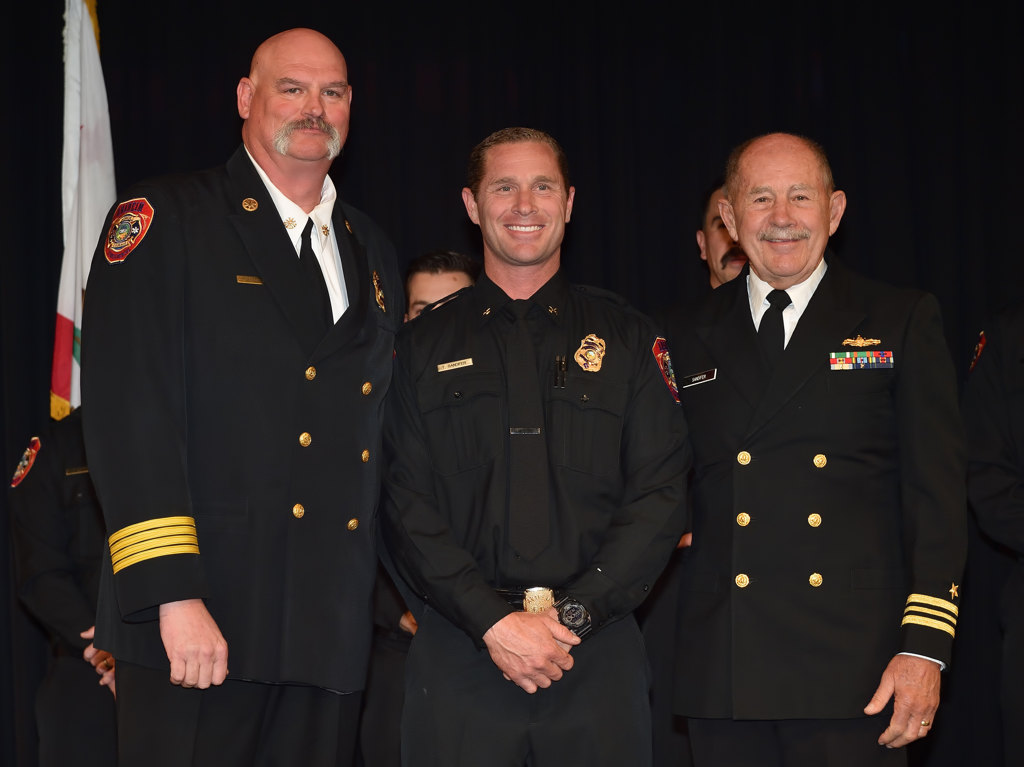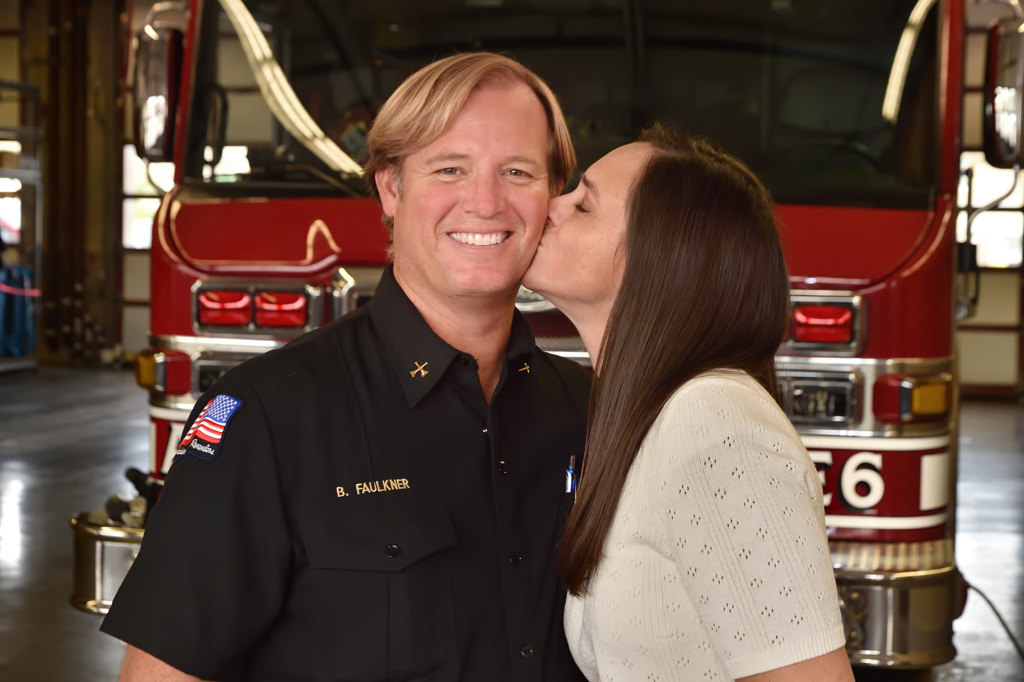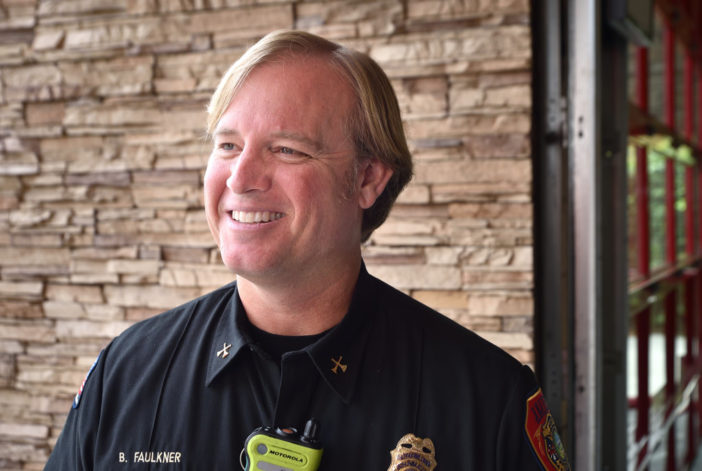On his first day as a new battalion chief for Anaheim Fire & Rescue, Brent Faulkner was still sipping his morning coffee when things got crazy.
The first call after his shift began at 6:30 a.m. was a man threatening to jump from an overpass on the 91 Freeway. Anaheim Police were able to talk the man down, and while Faulkner and another unit from Station 6 were en route to the scene, the call was cancelled.
The newly appointed “BC” – the rank is comparable to a lieutenant at a police agency, with lots of desk duties and meetings — turned around and headed back to the station.
Then, a call came in about a car that crashed into a motel room.
“All of this happened before 8:30 a.m.,” Faulkner recalls of that morning in August 2019.
In an unusually busy year for high-ranking promotions at AF&R, Faulkner is one of AFR’s three veterans who were appointed battalion chiefs in 2019.

In this file photo, AF&R Battalion Chief Michael Byard is congratulated by then-interim Fire Chief Pat Russell after receiving his new badge.
Photo by Steven Georges/Behind the Badge
The retirement of former Chief Randy Bruegman in December 2018, and the naming of Pat Russell as his replacement in July 2019, along with other retirements, opened up the three new BC positions.
AFR’s other new BCs are Tim Sandifer and Michael Byard.
“This is truly an honor and a privilege,” says Sandifer, an 18-year veteran of Anaheim Fire & Rescue. “I stand in the shadows of giants, and I will strive to continue their legacy.”
Says Byard, who started at AF&R in 2004: “I was very comfortable and happy being a captain paramedic. In many ways, I didn’t see myself in this role when I started in the fire service.
“It wasn’t until other mentors and influential members of our organization were able to open my eyes to the opportunity that exist in this position. When people that you respect and admire communicate to you that you have the skills necessary to be successful in the next position, you should probably listen and that’s how I ended up here.
“I’m very glad I listened to those individuals in the organization that I respect and admire. I really enjoy the position.”
TWO PER SHIFT
Battalion chiefs oversee captains, who are the top dogs at fire stations. Faulkner works out of Station 6 and has nine captains that report to him (one captain is assigned to every rig). There are a total of 36 personnel in Faulkner’s battalion, which includes Stations 2, 3, 4, 6, and 11.
There only are three ranks above BC: division chief, deputy chief, and chief.
Every day in Anaheim, two BCs are on duty per shift. AF&R has a total of seven BCs.

AF&R Battalion Chief Brent Faulkner, right, talks to a cable employee in Anaheim as he looks into a report of a downed power line.
Photo by Steven Georges/Behind the Badge
On a recent weekday, Faulkner and top brass at AF&R, including Chief Pat Russell, spent the morning at Station 11, on the west side of the city. They were there for an annual inspection. Every one of AF&R’s 11 stations gets inspected once a year to make sure all the required equipment is in order and that there are no safety issues.
As BCs, Faulkner, Byard, and Sandifer perform administrative and supervisory duties such as planning, coordinating, and directing the operational activities for fire suppression, emergency medical services, and hazardous material incidents for their assigned shifts.
They also provide administrative support to AF&R management staff.
EXCELLING AT THEIR JOBS
Byard and Sandifer never had plans to promote high up the ranks of AF&R. They just focused on being great at every job they had. The rest took care of itself.
Sandifer, who grew up in Huntington Beach, always wanted to be a firefighter.
“I literally started dreaming about it as a kid, and the dreams haven’t stopped,” he said.
Sandifer went to Edison High School and attended the fire academy, earning an associate’s degree at Santa Ana College. He has a bachelor’s degree in Emergency Services Management from Union Institute and University.
Sandifer became a paramedic in 2003, an engineer in 2007, and a captain in 2011.

In this file photo, AF&R Battalion Chief Tim Sandifer, center, smiles after receiving his new badge from then-Interim Fire Chief Pat Russell, left. Sandifer’s father, David, is on the right.
Photo by Steven Georges/Behind the Badge
“My goal is, and has always been, trying to help our department provide the best service to the public in the safest way we can,” says Sandifer, whose BC duties include managing AF&R’s training and wellness programs. “Promotion has helped with this through a greater sphere of influence.”
Sandifer, who is married with two children, says he strives to lead by example.
“Fortunately,” he says, “our firefighters hold themselves to a standard that negates the need for much management.”
A PIVOT
Byard, who grew up in La Habra, became interested in becoming a firefighter when he was in college.
“I’ve always been interested in team sports and have gravitated toward this type of work,” he says. “I enjoy the physical aspect of the job and the opportunity to be part of something greater than just myself.”
Byard attended private school in Whittier and again during high school at Orange Lutheran. He initially worked toward a business degree in college.
“I pivoted once I was exposed (to the fire service) through a close family friend who was a fire captain for the City of Vernon,” says Byard, who then focused on completing his fire academy and core fire classes.
In 2001, Byard was hired as a firefighter for the City of Vernon. AF&R picked him up in 2004.
Byard has a bachelor’s degree in Business Administration and a master’s degree in Organizational Leadership.
He became certified as a paramedic as well as a hazardous materials specialist. Byard also is certified as an Urban Search and Rescue Specialist and was part of AF&R’s Swiftwater team at Station 3.

AF&R Battalion Chief Brent Faulkner, left, attends a meeting at Anaheim Fire Station 11 with (from left) Capt. Dave Barry, Division Chief Kevin Stewart, Deputy Chief Mike Molloy, and Fire Chief Pat Russell.
Photo by Steven Georges/Behind the Badge
“I would say that I tend to lean toward looking for ways to be a leader as opposed to a manager in our organization,” Byard says of his management style. “I gravitate toward Blanchard’s Situational Leadership.
“Situational Leadership refers to when the leader or manager of an organization must adjust his/her style to fit the development level of the followers he/she is trying to influence.
“With situational leadership, it’s up to the leader to change his style, not the follower to adapt to the leader’s style. In situational leadership, the style may change continually to meet the needs of others in the organization based on the situation.
“Some of the greatest coaches and mentors throughout professional sports and the private sector exemplify this type of leadership. The ability to continually adapt to those you look to lead is what is necessary for long-term success, in my opinion.”
MEMORABLE CALL
Reflecting on his career thus far, Byard recalls one of his most memorable calls.
“One call that has always stuck in my mind was when I was a paramedic with a little boy,” he says. “The little boy was on his father’s shoulders walking on the outside of Disneyland. The child fell backward from his dad’s shoulders onto the concrete where be sustained a basilar skull fracture.
“The mother and father were obviously extremely upset, making the incident go from one patient to three. My partner and I were able to render the appropriate care, get him and his family to a trauma center, and have a successful recovery.
“My partner and I found out that he was walking into Disney for his birthday when he fell. Both of us felt so bad that we took him over a couple of toys and stuffed animals with balloons so in the hospital he could have a birthday celebration in some way. The family was very appreciative.”

In this file photo, AF&R Battalion Chief Brent Faulkner talks about his son, Eagle Scout Nominee Jared, at Fire Station 6.
Photo by Steven Georges/Behind the Badge
Byard, who is married with three young children, is an avid surfer who loves sports. He’s a huge Lakers fan, which is a good thing to be this season.
“I’m proud to work for one of the most respected agencies in the country,” Byard says. “The level of professionalism and dedication that so many members of this organization have is extremely humbling and motivating to myself at the same time. Thank you to the city and the citizen I serve for allowing me to represent the agency in this way.”
EQUIPPED FOR THE JOB
All of Anaheim Fire & Rescue’s BCs, who wear all-black uniforms, are assigned a red 2500 Dodge Ram truck with a camper shell on the back.
BCs roll to emergencies that require their skills as incident commanders. Their trucks are mini-command posts, complete with whiteboards and televisions to monitor news or to display video feeds from drones.
BCs do not respond to routine medical aid calls, which account for about 80 percent of all calls that come into AF&R stations. They roll to scenes involving multiple units.
Faulkner has been a firefighter for 23 years, spending his first four with the Riverside County Fire Department and the Jet Propulsion Laboratory Fire Department in Pasadena.
He says he’s always been interested in promoting to BC.
“I love being involved at whatever level I’m at,” says Faulkner, who has a master’s degree in leadership and management from the University of Redlands.
“I like leadership,” he says. “That’s something that’s important to me.”

In this file photo, AF&R Battalion Chief Brent Faulkner with his wife, Kelly, at Anaheim Fire Station 6.
Photo by Steven Georges/Behind the Badge
As part of the inspection, Faulkner leads a discussion in the chow room of Station 6. In addition to Chief Russell, attendees include Fire Marshal Alan Hogue, Division Chief Alan Long, Battalion Chief Tim Adams, Captain Dave Barry, Acting Operations Chief Kevin Stewart, Deputy Chief Mike Molloy, and Battalion Chief Bob McClellan.
“We as an organization are committed to spending a lot of money on safety gear and trying to have the latest and greatest technology,” Russell says, as a handful of Station 6 firefighters listen.
“Nothing happens as fast as we want,” Russell adds. “We’re always looking for money (but) we can’t snap our fingers.”
Russell stresses the importance of all AF&R station having up to take equipment, including the turnouts and masks firefighters wear.
“It all comes down to your guys’ safety and your ability to be operationally sound in your job,” Russell says. “We buy things that truly affect your operation on the ground. And that’s the commitment that this command staff has made to you guys. We train hard, we put a lot of time and money into training, and we put a lot of time and money into making sure you guys have the most up-to-date equipment.
“So you guys have got to do your part in making sure if you got a brush jacket that’s outdated, a hood, that we know about it. This is all about you guys going home and being safe and doing your job as efficiently as you can.”
PRACTICE
On this day, before the Station 11 inspection, Faulkner had to make sure there was backup for firefighters who had to undergo Type 3 engine (for wildfires) training.
Also, two rigs needed to go to the city yard for maintenance. Faulkner had to redeploy resources to cover for those missing rigs.
“A lot of my job is coordinating what is needed at different stations,” Faulkner says.
He also had to schedule when his USAR team could go Disneyland to examine and train on new “Star Wars” attractions after hours.

AF&R Battalion Chief Brent Faulkner rides code 3 in an Anaheim Battalion Chief Class 1 engine to a report of a downed power line.
Photo by Steven Georges/Behind the Badge
“If a ride starts and people get trapped, we have to know how get them down,” Faulkner says. “So we practice.”
The job of a BC also involves budgeting and writing reports.
“To write a report legibly and grammatically correct,” Faulkner says, “those are important things.”
Adds Faulkner: “We need to have business skills. Our job is so much more about putting out fires at this level. It’s about running a business.”
 Behind the Badge
Behind the Badge



